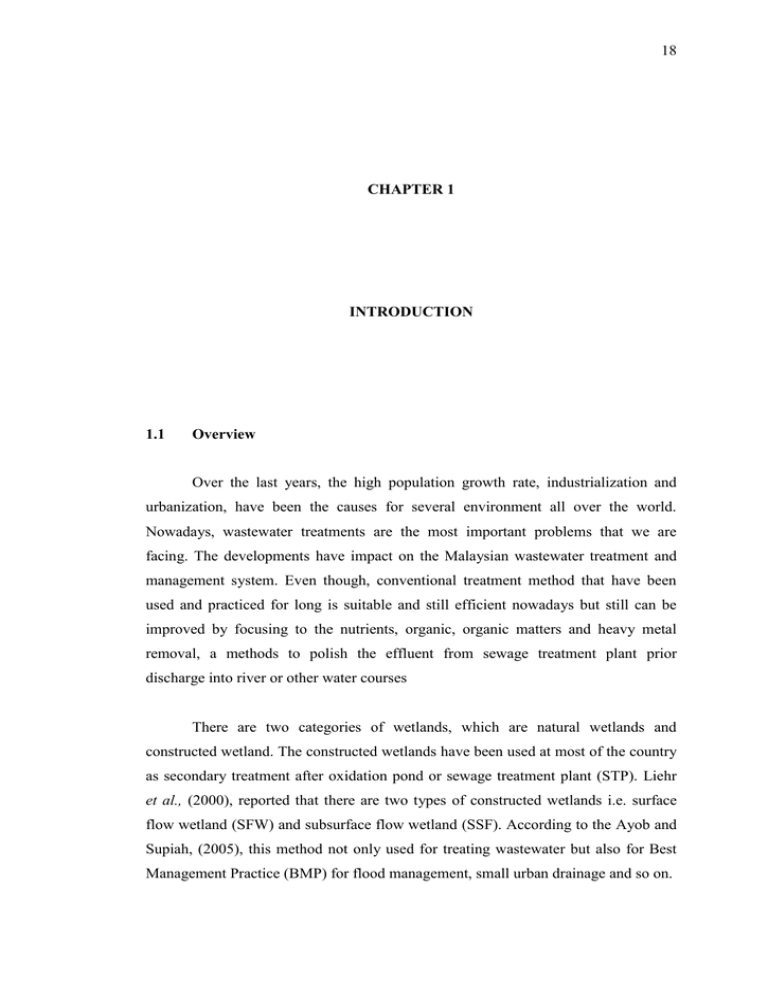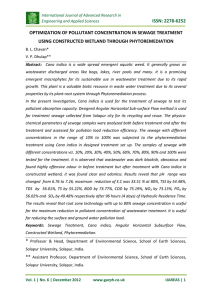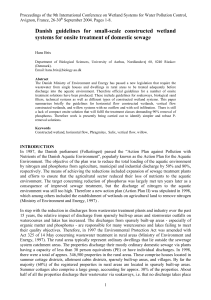18 Over the last years, the ... urbanization, have been the causes ...
advertisement

18 CHAPTER 1 INTRODUCTION 1.1 Overview Over the last years, the high population growth rate, industrialization and urbanization, have been the causes for several environment all over the world. Nowadays, wastewater treatments are the most important problems that we are facing. The developments have impact on the Malaysian wastewater treatment and management system. Even though, conventional treatment method that have been used and practiced for long is suitable and still efficient nowadays but still can be improved by focusing to the nutrients, organic, organic matters and heavy metal removal, a methods to polish the effluent from sewage treatment plant prior discharge into river or other water courses There are two categories of wetlands, which are natural wetlands and constructed wetland. The constructed wetlands have been used at most of the country as secondary treatment after oxidation pond or sewage treatment plant (STP). Liehr et al., (2000), reported that there are two types of constructed wetlands i.e. surface flow wetland (SFW) and subsurface flow wetland (SSF). According to the Ayob and Supiah, (2005), this method not only used for treating wastewater but also for Best Management Practice (BMP) for flood management, small urban drainage and so on. 19 Wetlands is a natural wastewater treatment where all the organic matters and nutrients are removed using vegetative plants with helps of other nature elements such as sunlight, temperature and oxygen at surrounding of wetlands. In term of cost it’s cheaper than other conventional sewage treatment plant because no any mechanical devices were applied in this process, (Kadlec and Knight, 1996) Olson (1992) and Mitsch (1992) stated that constructed wetlands have been used as an attractive low-cost method for controlling water pollution from both point and nonpoint sources. (Dundabin and Bowmer (1992) also reported that constructed wetland show good potential for removal metals from industrial wastewaters. Wetlands were also reported have potential to prevent the contamination of groundwater or to prevent groundwater from infiltrating into the wetland (Kadlec et al., 2000). As reported by Olson (1992), wetlands can contribute in reducing heavy metal and nutrient significantly in wastewater to improve the water quality. On the other hand, constructed wetlands are also used to improve or restore some water bodies such as rivers and water basins (Nairn and Mitsch, 2000; Mitsch et al., 2005 and Mitsch and Day, 2006). Among the aquatic treatment systems, constructed wetlands have a greater potential in wastewater treatment because they can tolerate higher organic loading rate and shorter hydraulic retention time with improved effluent characteristics (Chongrak and Lim, 1998). 1.2 Objective of Study There are two objectives that are outlined for this study, as the followings: i. To investigate the performance of the constructed wetland with vetiveria zizaniodes in treating sewage under different hydraulic retention time HRT-0 (no flow) and HRT-5days; ii. To examine the effect of the constructed wetland system on sewage quality for pH, Dissolve Oxygen (DO), Total Suspended Solids (TSS), Biological 20 Oxygen Demands (BOD), oil and grease, Ammonia Nitrogen (NH3-N), and Orthophosphate (PO43-) 1.3 Scope of Study The experiment of removing the organic matters, total suspended solid, and nutrients in sewage using subsurface flow constructed wetland was conducted at Environmental Engineering Laboratory, Faculty of Civil Engineering, Universiti Teknologi Malaysia (UTM). Sewage is taken from the oxidation pond at Kolej Tun Canselor (KTC) UTM Skudai. The parameters used for analyses are organic matters i.e. BOD, oil & grease, TSS, and nutrients i.e. ammonia nitrogen and phosphate. 1.4 Problem of Statement As cities are growing in size with a rise in the population, the amount of waste generated is increasing becoming unmanageable. As an alternative, constructed wetlands are suitable for treating wastewater which can be very harmful to living things if not properly treated. The problem with wastewater treatment is that wastewater changes in terms of strength, biodegradability, and toxicity as the generation of wastewater is depend on the number of population, cultures, type of sewer etc. 1.5 Significance of the Study The findings of the study are important to discover the performance of constructed wetlands in treating and removing organic matters, and nutrients in the sewage. From the analyses we can evaluate the efficiency of wetland in treating sewage and determine the benefits of using wetland. Constructed wetlands can be used as a new method of treatment that could be applied to treat sewage which is more environmentally friendly, and less operating cost.




